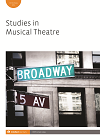
Full text loading...
The critical reception of Bill T. Jones’s choreography for the Broadway stage reinvigorates debates about high and low cultural production and reveals persistent critical biases regarding the requirement of authenticity for non-white artists. Jones’s genre crossing participates in a cultural history of choreographers and dancers who dance(d) across concert and commercial stages; Jones’s work is further complicated by a rubric of authenticity as it contributes to both the mythology of the avant-garde and audience expectations of racialized cultural producers. This article argues that the reception of Jones’s choreography evidences the interdependence between blackness as authenticity and high/low dichotomies of artistic production, particularly those that contour dance reception. I foreground the multiple ways in which the formulation of blackness as authenticity supports Broadway’s commercial, often posited as ‘inauthentic’, aesthetics and aims.

Article metrics loading...

Full text loading...
References


Publication Date:
https://doi.org/10.1386/smt.13.1.23_1 Published content will be available immediately after check-out or when it is released in case of a pre-order. Please make sure to be logged in to see all available purchase options.